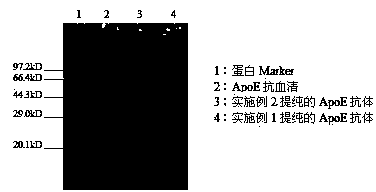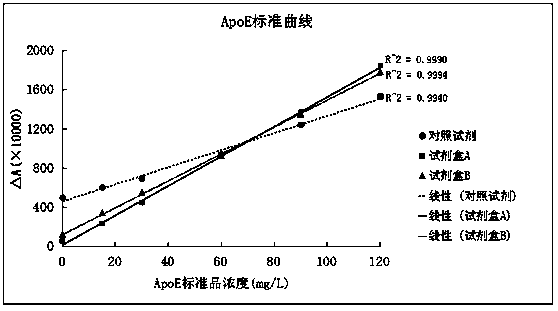Apolipoprotein E detection kit
A detection kit and apolipoprotein technology, applied in the field of human biological protein detection, can solve the problems of low operator risk, specificity, poor affinity, low antibody titer, etc.
- Summary
- Abstract
- Description
- Claims
- Application Information
AI Technical Summary
Problems solved by technology
Method used
Image
Examples
Embodiment 1
[0057] In this example, the kit A was prepared by using the ApoE antibody purified from the ApoE antiserum by the ammonium sulfate method.
[0058] 1) ApoE antibody purification
[0059] Slowly add solid ammonium sulfate at 0.25 g / mL serum to 100 ml of ApoE antiserum, stir in an ice-water bath for 2 hours, and let stand for 2 hours. Centrifuge at 10,000 rpm for half an hour, discard the supernatant, and dissolve the ammonium sulfate precipitate with phosphate buffer. The resuspension was dialyzed against PBS until the dialysate was free of ammonium ions. The dialyzed antibody was centrifuged at 10000rpm for half an hour, the supernatant was taken to obtain the ApoE antibody, and the volume was adjusted to 100ml with PBS.
[0060] 2) Reagent R1 (the reagent is a colorless and transparent solution): pH7.4
[0061] Phosphate buffer 25mmol / L
[0062] Polyethylene glycol 6000 25g / L
[0063] Sodium chloride 100mmol / L
[0064] Tween 20 0.1%
[0065] NaN3 0.1%
[0066] BSA 0.1...
Embodiment 2
[0077] In this example, the kit B was prepared by using the ApoE antibody purified from the ApoE antiserum by the ammonium sulfate-DEAE ion column method.
[0078] 1) ApoE antibody purification
[0079] Slowly add solid ammonium sulfate at 0.25 g / mL serum to 100 ml of ApoE antiserum, stir in an ice-water bath for 2 hours, and let stand for 2 hours. Centrifuge at 10,000 rpm for half an hour, discard the supernatant, and dissolve the ammonium sulfate precipitate with PBS solution. The resuspension was fully dialyzed against 20mM PBS pH 6.0, centrifuged to take the supernatant, passed through a DEAE anion chromatography column equilibrated with 20mM PBS pH 6.0, and the passing liquid was collected to obtain the ApoE antibody, and 1 / 10 volume of 10 ×PBS.
[0080] 2) Reagent R1 (the reagent is a colorless and transparent solution): pH7.4
[0081] Phosphate buffer 25mmol / L
[0082] Polyethylene glycol 6000 25g / L
[0083] Sodium chloride 100mmol / L
[0084] Tween 20 0.1%
[008...
Embodiment 3
[0097] The difference between this embodiment and embodiment 1 is only:
[0098] 1) Reagent R1 (the reagent is a colorless and transparent solution): pH7
[0099] Phosphate buffer 10mmol / L
[0100] Polyethylene glycol 6000 15g / L
[0101] Sodium chloride 50mmol / L
[0102] Tween 20 0.02%
[0103] NaN3 0.1%
[0104] BSA 0.01%
[0105] 2) Reagent R2 (the reagent is a colorless and transparent solution): pH7
[0106] Phosphate buffer 10mmol / L
[0107] Sodium chloride 75mmol / L
[0108] NaN3 0.1%
[0109] Tween 20 0.15%
[0110] ApoE antibody 20% (v / v)
[0111] 3) ApoE reference standard
[0112] The standard in standard diluent is: 50mM phosphate buffer, 125mM NaCl, 1%BSA, 0.2mM EDTA, 0.12% Tween 20, 0.1%NaN 3 , pH7, tested with a commercially available control reagent and adjusted to ApoE antigen 120mg / L, aliquoted and stored at -20°C. Take it out before use, and dilute it into different concentrations of ApoE standard with standard diluent (ApoE antigen concentration: 0...
PUM
 Login to View More
Login to View More Abstract
Description
Claims
Application Information
 Login to View More
Login to View More - R&D
- Intellectual Property
- Life Sciences
- Materials
- Tech Scout
- Unparalleled Data Quality
- Higher Quality Content
- 60% Fewer Hallucinations
Browse by: Latest US Patents, China's latest patents, Technical Efficacy Thesaurus, Application Domain, Technology Topic, Popular Technical Reports.
© 2025 PatSnap. All rights reserved.Legal|Privacy policy|Modern Slavery Act Transparency Statement|Sitemap|About US| Contact US: help@patsnap.com



